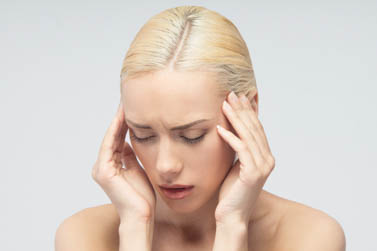Acupuncture provides important therapeutic clinical benefits for trigeminal neuralgia patients and shortens the duration of hospitalization. A recent investigation finds acupuncture effective in eliminating trigeminal neuralgia symptoms with both a high cure rate and total effective rate.  Trigeminal neuralgia is a severe facial pain disorder following the distribution of cranial nerve V. The pain is often unilateral, stabbing, paroxysmal, and excruciating. The condition is exacerbated by daily activities including speaking, chewing, smiling, cold or hot fluid intake, physical touch, exposure to cold air, and teeth brushing.
Trigeminal neuralgia is a severe facial pain disorder following the distribution of cranial nerve V. The pain is often unilateral, stabbing, paroxysmal, and excruciating. The condition is exacerbated by daily activities including speaking, chewing, smiling, cold or hot fluid intake, physical touch, exposure to cold air, and teeth brushing.
Researchers conducted a controlled experiment comparing the efficaciousness of carbamazepine with acupuncture. Carbamazepine is an FDA approved anticonvulsant drug used for the treatment of trigeminal neuralgia and is also used for controlling seizures in epileptic patients and mania in bipolar patients. A total of 22 out of 40 patients in the carbamazepine group fully recovered. A total of 30 out of 40 patients fully recovered in the acupuncture group. This yields a 55% cure rate for carbamazepine and 70% for acupuncture.
Acupuncture demonstrated a higher total effective rate than carbamazepine. The total effective rate includes all patient improvements ranging from mild to cured. Carbamazepine achieved an 87.50% total effective rate and acupuncture achieved a 95% total effective rate. Based on the findings, the researchers suggest implementing a Traditional Chinese Medicine (TCM) protocol for patients with trigeminal neuralgia wherein both pharmaceutical medications and acupuncture are combined in a treatment regimen. They suggest that this may produce even greater results than using either modality as a standalone therapy. Acupuncture continuing education research is needed to determine if an additive or synergistic effect can be achieved by combining drugs with TCM procedures for the treatment of trigeminal neuralgia.
The study randomly and evenly divided 80 patients with primary stage trigeminal neuralgia into an acupuncture group and a carbamazepine group. The 40 outpatients from the acupuncture group consisted of 16 male and 24 female patients ranging from 45 to 68 years old with an average symptom duration of approximately 9 years.  The carbamazepine group was comprised of 18 male and 22 female patients ranging from 47 to 69 years old with an average symptom duration of approximately 10 years. Before their treatments, all patients underwent a full physical examination and head CT scan. All had similar symptoms including speaking and eating difficulties, advanced complexes of pain, and face muscle cramping.
The carbamazepine group was comprised of 18 male and 22 female patients ranging from 47 to 69 years old with an average symptom duration of approximately 10 years. Before their treatments, all patients underwent a full physical examination and head CT scan. All had similar symptoms including speaking and eating difficulties, advanced complexes of pain, and face muscle cramping.
Treatment Methods
The carbamazepine group patients initially consumed 100 mg carbamazepine tablets, 2 times per day. The rate of consumption was subsequently increased to 4 times per day and the dosage was increased incrementally according to a patient’s condition. The maximum dosage was set to a limit of 1 g per day. If pain levels significantly reduced per a specific dosage range within 2 days, carbamazepine consumption was regulated at 500 - 800 mg per day.
The acupuncture group received the application of filiform acupuncture needles at the following acupoints:
- Tai Yang (Supreme Yang)
- LI4 (Hegu, Joining Valley)
- LI7 (Wenliu, Warm Flow)
- ST7 (Xiaguan, Lower Controller)
- Yin Tang (Hall of Impression)
- DU20 (Baihui, Hundred Meetings)
- GB20 (Fengchi, Wind Pool)
- ST6 (Jiache, Jaw Bone)
Acupuncture was first applied to Tai Yang. Next, 2 - 3” needling was threaded from ST6 along the zygomatic arch. Evoking intense soreness at the two points noticeably induced analgesia. Next, Bai Hui was needled horizontally for 0.7” and Yin Tang for 0.3”. GB20 was needled at the appropriate angle towards the eyes to a depth of 1”. The last stage involved application of acupuncture to LI4 and LI7.
Acupuncture was effective for the resolution of trigeminal neuralgia using this powerful treatment procedure. The advantage of acupuncture over carbamazepine is that there is no risk of life-threatening allergic reactions. Use of carbamazepine involves the risk of Stevens-Johnson syndrome and toxic epidermal necrolysis, particularly in Asian patients with a genetic risk factor. In addition, acupuncture was found clinically more effective than carbamazepine. Notably, the researchers suggest that combining medications with acupuncture may produce even greater patient outcomes than using either therapy separately.
References:
Chen Kepeng, Tian Long, Clinical discussion on treating primary trigeminal neuralgia, Clinical Journal of Chinese Medicine, 2015 (13).
Xia Caiqiu, Xun Xuelian, Liu Shuang, Wang Chunbo, Liu Mingliang, , Discussion on primary trigeminal neuralgia treatments, Chinese Journal of Modern Drug Application, 2010 (4).


